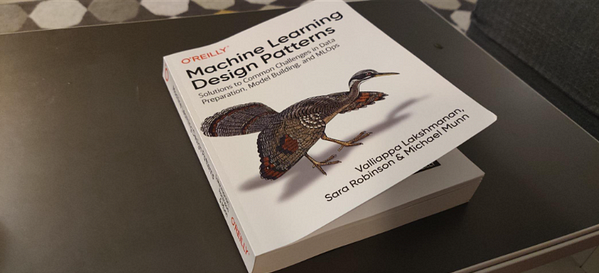Empowering Your Machine Learning Projects: Best Practices and Design Patterns for Success

A series of articles focusing on the “Machine Learning Design Patterns, solutions to common challenges in data preparation, model building and MLOps” book by Valliappa Lakshmanan, Sara Robinson, and Michael Munn.

In the ever-evolving world of technology, machine learning has emerged as a powerful force, revolutionising countless industries and reshaping how we interact with data. From healthcare and finance to e-commerce and self-driving cars, machine learning has become an integral part of our daily lives.
With its growing prominence, navigating the complex landscape of ML design patterns has become essential for professionals in the field. However, amid this intricate terrain, practitioners often stumble upon common mistakes that hinder the development and deployment of effective ML systems.

So, whether you’re a seasoned data scientist seeking to refine your skills or a newcomer eager to venture into the world of machine learning, this series promises to offer invaluable insights and practical solutions. Join us as we navigate the fascinating world of ML design patterns and unlock the full potential of this comprehensive guide.
Why do we need machine learning design patterns ?

Design patterns serve as a means of addressing common issues in machine learning by offering widely-used and successful ML designs that can be applied repeatedly, in other words, Best practices.
They provide a way of thinking when creating solutions or developing ML systems. The question arises whether we can extract the best practices of machine learning and convert them into design patterns.
As defined by Wikipedia, design patterns are established best practices that programmers can adopt to solve common problems while designing applications or systems.
A new book, “Machine Learning Design Patterns”, was recently published on the subject, which explains in detail 30 patterns that are categorised.
So, get ready to explore the world of ML design patterns and let’s dive into the book!
Overview of the book : “Machine Learning Design Patterns” by Valliappa Lakshmanan, Sara Robinson, and Michael Munn :
The book is a comprehensive guide that presents a collection of design patterns and best practices for building robust and scalable machine learning systems.

The book is organised into the following chapters:
Data representation design patterns:
Data representation is a key aspect of machine learning, and the way data is represented can have a significant impact on the performance of machine learning models.
Data representation ML design patterns provide best practices for representing and preprocessing data in machine learning models.
This involves techniques like :
- #1 Hashed Feature
- #2 Embedding
- #3 Feature Cross
- #4 Multimodal Input
Problem representation design patterns:
Problem representation ML design patterns provide solutions for defining and representing machine learning problems in a way that enables effective modelling.
These patterns can help to ensure that the problem is well-defined, the data is properly formatted, and the features are relevant to the task at hand. By using problem representation design patterns, machine learning practitioners can improve the quality and accuracy of their models.
The patterns that are discussed in the book are as follows:
- #5 Reframing
- #6 Multilabel
- #7 Ensemble
- #8 Cascade
- #9 Neutral Class
- #10 Rebalancing
Patterns that modify model training:
Patterns that modify model training focus on enhancing and optimising the training process of models, like:
- #11 Useful overfitting
- #12 Checkpoints
- #13 Transfer Learning
- #14 Distribution Strategy
- #15 Hyperparameter Tuning
Resilience patterns:
Resilience patterns in ML design provide solutions to common challenges that arise during the development and deployment of models. These patterns focus on building models that are robust, scalable, fault-tolerant and can handle unexpected errors and failures.
Resilience patterns include techniques such as:
- #16 Stateless Serving Function
- #17 Batch Serving
- #18 Continuous Model Evaluation
- #19 Two Phase Predictions
- #20 Keyed Predictions
Reproducibility patterns:
Reproducibility patterns in ML design patterns provide a standardized approach for ensuring that ML experiments can be reproduced reliably. These patterns include best practices for version control, data and code documentation, and experiment tracking, among other things.
By using reproducibility patterns, machine learning practitioners can make their experiments more transparent, shareable, and trustworthy, enabling others to reproduce and build upon their work.
Such patterns are:
- #21 Transform
- #22 Repeatable Sampling
- #23 Bridged Schema
- #24 Windowed Inference
- #25 Workflow Pipeline
- #26 Feature Store
- #27 Model Versioning
Responsible AI:
Responsible AI ML design patterns are a set of standardised solutions to common problems in building machine learning models that prioritise fairness, transparency, accountability, and ethical considerations.
These design patterns aim to ensure that models are developed in a responsible and ethical manner, and that they do not perpetuate or amplify biases, discrimination, or other harmful outcomes.
Such as:
- #28 Heuristic benchmark
- #29 Explainable Predictions
- #30 Fairness Lens
By using responsible AI design patterns, machine learning practitioners can build more trustworthy and socially responsible systems.
What readers can expect from this article series ?

Our target audience for this series includes data scientists, ML engineers, and anyone with an interest in expanding their knowledge of machine learning design patterns.
The article series will cover different topics related to data preparation, model building, and MLOps, including data cleaning, feature scaling, model evaluation, hyperparameter tuning, model deployment, and more.
So sit back, relax, and get ready to explore the fundamentals of ML design patterns. With this comprehensive guide authored by Lakshmanan, Sara Robinson and Michael Munn, as our roadmap to hopefully help you create accurate, effective, and efficient models.
Happy Learning!!







